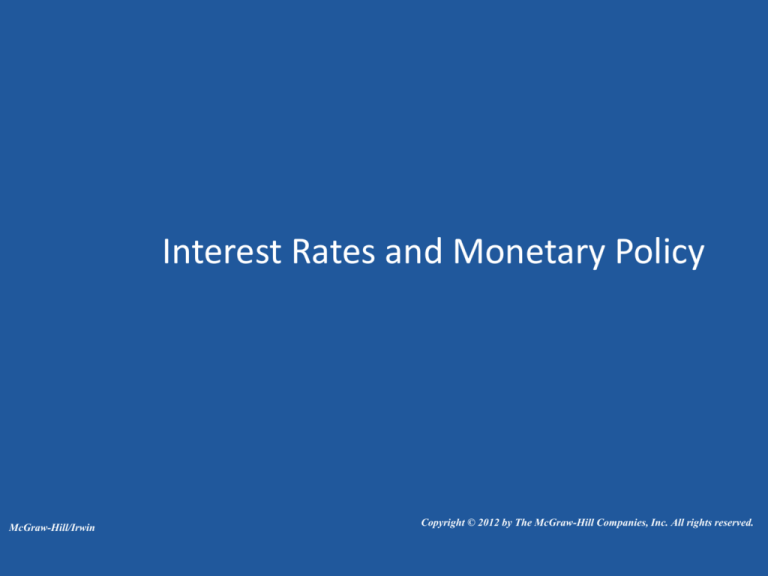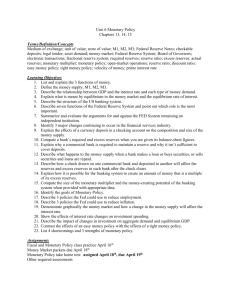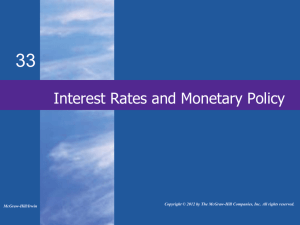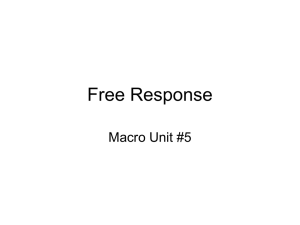
Interest Rates and Monetary Policy
McGraw-Hill/Irwin
Copyright © 2012 by The McGraw-Hill Companies, Inc. All rights reserved.
•
•
•
•
LO1
Interest Rates
The price paid for the use of money
Many different interest rates
Speak as if only one interest rate
Determined by the money supply and
money demand
16-2
Earlier we said that the interest rate
(r) influences aggregate spending—
specifically investment and
consumption. However, we have yet
to develop a theory of the interest
rate
The interest rate is
governed by the
demand and supply of
money.
1. To make planned
expenditures/payments
2. To be prepared for
unexpected
expenditures/payments.
3. To store wealth.
•
•
•
•
LO1
Demand for Money
Why hold money?
Transactions demand, Dt
–Determined by nominal GDP
–Independent of the interest rate
Asset demand, Da
–Money as a store of value
–Varies inversely with the interest rate
Total money demand, Dm
16-5
The higher the interest rate,
the more interest I give up by
holding my wealth in money- as opposed to an interestbearing asset.
Rate of interest, i percent
Demand for Money
(a)
Transactions
demand for
money, Dt
(b)
Asset
demand for
money, Da
10
Sm
7.5
=5
+
5
2.5
Dt
0
50
100
Da
150
200
Amount of money
demanded
(billions of dollars)
LO1
(c)
Total
demand for
money, Dm
and supply
50
100
150
200
Amount of money
demanded
(billions of dollars)
Dm
50
100
150
200
250
300
Amount of money
demanded and supplied
(billions of dollars)
16-7
Classical Theory of Interest
DI = C + S
“Interest is the reward for waiting.”
Keynes: Interest is the reward for
parting with liquidity.
Demand for Money
Nominal Interest Rate (%)
•As we move along DM, nominal
GDP is held constant.
E
6%
•The movement from point E to F is
a change in the demand for money
as a store of value in reaction to a
decrease in the yield of bonds.
F
3%
DM
0
1.0
1.2
Money
($Trillions)
Nominal Interest Rate (%)
Effect of a Change in nominal GDP (Y)
Dm1 Dm2
•Increase in Y, ceteris paribus
E
6%
G
F
H
3%
Dm1
0
1.0
1.12
1.2
1.5
Dm2
Money
($Trillions)
•
•
LO1
Interest Rates
Equilibrium interest rate
–Changes with shifts in money supply
and money demand
Interest rates and bond prices
–Inversely related
–Bond pays fixed annual interest
payment
–Lower bond price will raise the interest
rate
16-11
Bond Prices and the Rate Of Interest
Bond prices and
interest rates (or
yields), move
inversely
Suppose you paid $800 for a bond that promises to pay
$1,000 to its holder one year from today. What is the interest
rate or percentage yield of the bond? Notice first that your
interest income would be equal to $200. Hence to compute
the yield, use the following equation:
Yield (%) = (interest income/price of the bond) 100
Thus, we have:
Yield (%) = (200/800) 100 = 25 percent
Now suppose, instead of paying $800 for the bond, you
paid $900. What is the yield now?
Yield (%) = (100/900) 100 = 11 percent
Federal Reserve Balance Sheet
• Assets
–Securities
–Loans to commercial banks
• Liabilities
–Reserves of commercial banks
–Treasury deposits
–Federal Reserve Notes outstanding
LO2
16-14
Federal Reserve Balance Sheet
March 24, 2010 (in Millions)
Assets
Liabilities and Net Worth
Securities
Loans to Commercial
Banks
All Other Assets
$2,017,955
Total
$2,316,525
85,659
212,911
Reserves of Commercial
$ 1,147,747
Banks
150,087
Treasury Deposits
Federal Reserve Notes
893,035
(Outstanding)
125,656
All Other Liabilities and
Net Worth
$2,316,525
Total
Source: Federal Reserve Statistical Release, H.4.1, March 24, 2010, http://www.federalreserve.gov
LO2
16-15
Central Banks
LO2
16-16
•
•
LO2
Tools of Monetary Policy
Open market operations
–Buying and selling of government
securities (or bonds)
–Commercial banks and the general
public
–Used to influence the money supply
When the Fed sells securities,
commercial bank reserves are reduced
16-17
•
Tools of Monetary Policy
Fed buys bonds from commercial banks
Federal Reserve Banks
Assets
Liabilities and Net Worth
+ Securities
+ Reserves of Commercial
Banks
(a) Securities
Assets
(b) Reserves
Commercial Banks
Liabilities and Net Worth
-Securities (a)
+Reserves (b)
LO2
16-18
•
Tools of Monetary Policy
Fed sells bonds to commercial banks
Federal Reserve Banks
Assets
Liabilities and Net Worth
- Securities
- Reserves of Commercial
Banks
(a) Securities
Assets
(b) Reserves
Commercial Banks
Liabilities and Net Worth
+ Securities (a)
- Reserves (b)
LO2
16-19
Open Market Operations
• Fed buys $1,000 bond from a
commercial bank
New Reserves
$1000
Excess
Reserves
$5000
Bank System Lending
Total Increase in the Money Supply, ($5,000)
LO2
16-20
Open Market Operations
• Fed buys $1,000 bond from the
public
Check is Deposited
New Reserves
$1000
$800
Excess
Reserves
$4000
Bank System Lending
$200
Required
Reserves
$1000
Initial
Checkable
Deposit
Total Increase in the Money Supply, ($5000)
LO2
16-21
•
•
•
LO2
Tools of Monetary Policy
The reserve ratio
–Changes the money multiplier
The discount rate
–The Fed as lender of last resort
–Short term loans
Term auction facility
–Introduced December 2007
–Banks bid for the right to borrow
reserves
16-22
The Reserve Ratio
Effects of Changes in the Reserve Ratio
LO2
(1)
Reserve
Ratio, %
(2)
Checkable
Deposits
(3)
Actual
Reserves
(4)
Required
Reserves
(5)
Excess
Reserves,
(3) –(4)
(6)
Money-Creating
Potential of
Single Bank, = (5)
(7)
Money-Creating
Potential of
Banking System
(1) 10
$20,000
$5000
$2000
$3000
$3000
$30,000
(2) 20
20,000
5000
4000
1000
1000
5000
(3) 25
20,000
5000
5000
0
0
0
(4) 30
20,000
5000
6000
-1000
-1000
-3333
16-23
Tools of Monetary Policy
• Open market operations are the most
•
•
•
LO2
important
Reserve ratio last changed in 1992
Discount rate was a passive tool
Term auction facility is new
–Guaranteed amount lent by the Fed
–Anonymous
16-24
FED exercised lender-of-last-resort function
during 2008-2009 financial crisis
140 Bank Failures (FDIC-Insured) in 2009
Failures of FDIC Insured Finanical Institutions
450
400
350
Number
300
250
200
150
100
50
0
Year
See WSJ interactive graphic
http://graphicsweb.wsj.com/documents/Failed-US-Banks.html
The Federal Funds Rate
• Rate charged by banks on overnight
•
•
•
•
LO3
loans
Targeted by the Federal Reserve
FOMC conducts open market operations
to achieve the target
Demand curve for Federal funds
Supply curve for Federal funds
16-27
Federal Funds Rate, Percent
The Federal Funds Rate
Using Open Market Operations
4.5
Sf 3
4.0
Sf 1
3.5
Sf 2
Df
Qf3
Qf1
Qf2
Quantity of Reserves
LO3
16-28
Monetary Policy
• Expansionary monetary policy
–Economy faces a recession
–Lower target for Federal funds rate
–Fed buys securities
–Expanded money supply
–Downward pressure on other interest
rates
LO3
16-29
Monetary Policy
• Restrictive monetary policy
–Periods of rising inflation
–Increases Federal funds rate
–Increases money supply
–Increases other interest rates
LO3
16-30
Monetary Policy
10
8
Prime interest rate
Percent
6
4
Federal funds rate
2
0
1998
1999
2000
2001 2002
2003
2004
2005
2006
2007
2008
2009 2010
Year
16-31
Interest
rate
Effect of an increase in the money supply
Because the money supply is
determined by the Federal Reserve,
it can be represented by a vertical
line.
S’m
Sm
At point a, the intersection of the
money supply, Sm, and the money
demand, Dm, determines the market
interest rate, i.
a
i
b
i’
Dm
0
M
M’
Quantity of
money
Following an increase in the money
supply to S’m, the quantity of money
supplied exceeds the quantity
demanded at the original interest
rate, i.
People attempt to exchange money for bonds or other financial assets. In doing so,
they push down the interest rate to i’, where quantity demanded equals quantity
supplied. This new equilibrium occurs at point b.
32
i’
Sm
S’m
a
b
(b) Demand for
investment
i
a
i’
(c) Aggregate demand
Price level
i
(a) Supply and demand
for money
Interest rate
Interest rate
Effects of an increase in the money supply on
interest rates, investment, and aggregate
demand
b
P
b
a
AD’
Dm
AD
DI
0
I I’
M
M’ Money
Investment
An increase in the money
supply drives the interest
With the cost of borrowing
rate down to i'.
lower, the amount invested
increases from I to I‘.
0
0
Y
Y’
Real GDP
This sets off the spending
multiplier process, so the
aggregate output demanded at
price level P increases from Y to
33
Y‘
•
•
•
•
LO4
Monetary Policy, Real GDP, Price Level
Affect on real GDP and price level
Cause-effect chain
–Market for money
–Investment and the interest rate
–Investment and aggregate demand
–Real GDP and prices
Expansionary monetary policy
Restrictive monetary policy
16-34
(a)
The market
for money
Sm1
Sm2
Sm3
AS
10
P3
8
AD3
I=$25
AD2
I=$20
AD1
I=$15
P2
Dm
6
ID
0
$125
$150
$175
Amount of money
demanded and
supplied
(billions of dollars)
LO4
(c)
Equilibrium real
GDP and the
Price level
(b)
Investment
demand
Price Level
Rate of Interest, i (Percent)
Monetary Policy and Equilibrium GDP
$15
$20
$25
Amount of investment
(billions of dollars)
Q1
Qf Q3
Real GDP
(billions of dollars)
16-35
Monetary Policy and Equilibrium GDP
(d)
Equilibrium real
GDP and the
Price level
(c)
Equilibrium real
GDP and the
Price level
AS
AS
P3
AD3
I=$25
AD2
I=$20
AD1
I=$15
P2
Q1
Qf Q3
Real GDP
(billions of dollars)
b
a
AD3
I=$25
AD4
I=$22.5
AD2
I=$20
AD1
I=$15
Price Level
Price Level
P3
LO4
c
P2
Q1
Qf Q3
Real GDP
(billions of dollars)
16-36
Expansionary Monetary Policy
CAUSE-EFFECT CHAIN
Problem: Unemployment and Recession
Fed buys bonds, lowers reserve ratio, lowers the
discount rate, or increases reserve auctions
Excess reserves increase
Federal funds rate falls
Money supply rises
Interest rate falls
Investment spending increases
Aggregate demand increases
Real GDP rises
LO4
16-37
Restrictive Monetary Policy
CAUSE-EFFECT CHAIN
Problem: Inflation
Fed sells bonds, increases reserve ratio, increases
the discount rate, or decreases reserve auctions
Excess reserves decrease
Federal funds rate rises
Money supply falls
Interest rate rises
Investment spending decreases
Aggregate demand decreases
Inflation declines
LO4
16-38
Recent U.S. Monetary Policy
• Highly active in recent decades
• Responded with quick and innovative
•
LO5
actions during the recent financial crisis
and the severe recession
Critics contend the Fed contributed to
the crisis by keeping the Federal funds
rate too low for too long
16-39
Banks have excess reserves, but are
not making loans
Problems and Complications
• Lags
–Recognition and operational
–Cyclical asymmetry
–Liquidity trap
LO5
16-41








